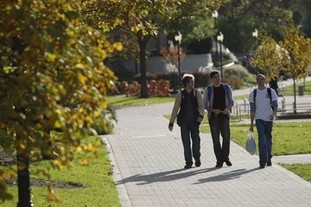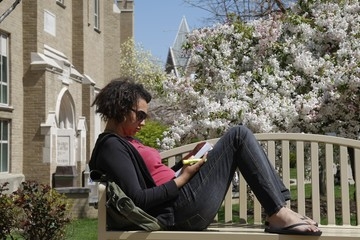The Place of Sustainability and the Environment within
Roman Catholic Thought
Sustainability Day 2011
Michael J. Graham, S.J., President.
Xavier University, November 7, 2011
During the brief time that I have to speak to you today, I want to focus on the place of sustainability and the environment within recent Roman Catholic thought. I will do so in two broad halves: Looking first at general Roman Catholic sources, but especially the thought of our current Pope, Benedict XVI; and then exploring the themes in recent Jesuit documents. Let me state my conclusion up front. It is clear to me through this survey of recent work that the Roman Catholic Church and, within it, the Society of Jesus are discovering multiple ways to connect concern for the environment to other basic moral and theological concerns and approaches, in multiple ways. This is important for at least two reasons, one of them as broad as broad can be and the other completely local. It is important, first, because the enormity of the task of environmental reconciliation before us very likely will not happen unless our major symbolic systems are re-imagined in light of the environment, and this is precisely what we can see happening in contemporary Catholicism, reflected both by Pope Benedict and the Society of Jesus. The local reason pertains to us here at Xavier University. This seismic shift in contemporary Catholic thought means that our mission as a Jesuit, Catholic university cannot be fulfilled as such without an on-going and ever-greater appropriation of sustainability across the entire horizon of University activities.

Though one can find generic comments on the environment, such as that in the Catechism, dating back to Pope Paul VI in 1971, it was really Pope John Paul II who began highlighting the issue. For example, in 1990, he spoke of an ?ecological crisis, and called as a result for the ?urgent moral need for a new solidarity. These remarks were made in his Message for the World Day of Peace on January 1, 1990, a message entitled Peace with God the Creator, Peace with all of Creation. A comprehensive anthology of Roman Catholic social teaching that he oversaw late in his pontificate called The Compendium of the Social Doctrine of the Church (2004) likewise began to focus attention on issues that we would today recognize as sustainability issues. For example, in Chapter 10, Safeguarding the Environment, the Compendium asserts that responsibility for the environment, the common heritage of mankind, extends not only to present needs but also to those of the future ,and that this is a responsibility that present generations have toward those of the future, creating a kind of intergenerational solidarity around environmental questions. Likewise, the document asserted the right to a safe and healthy natural environment and as well began linking environment issues to other justice issues in multiple and interconnected ways. The environmental crisis and poverty, the document contends are connected by a complex and dramatic set of causes that can be resolved by the principle of the universal destination of goods, which offers a fundamental moral and cultural orientation. I will return later to this theme of the interconnection of the environment and justice. Finally, the document summoned us to adopt new lifestyles and effective change[s] of mentality, in effect, moral conversion, another theme we will see recur.
It has been John Paul's successor, however, Benedict XVI, who has made environmental issues a fundamental concern of his teaching. Indeed, I strongly suspect that the verdict of a history I will not live to see is that Benedict, as the first ?Green Pope, has made it effectively impossible for the papacy not to be green. The fourth chapter of his 2009 Encyclical Caritas in Veritate (Charity in Truth), for example, is devoted in large part to the theme of human beings and their environment. The chapter begins with a trumpet-blast of a quotation from Paul VI: The reality of human solidarity, which is a benefit for us, also imposes a duty. Benedict's argument in this chapter is that rights presuppose duties if they are not to become mere license, and after a consideration of proper understanding of the economy and development, goes on to treat a variety of topics pertinent to the environment: energy, responsible stewardship over nature, the need for intergenerational solidarity, and so on. Among his most important insights is to be found in #51: The way humanity treats the environment influences the way it treats itself, and vice versa a statement which begins to assert and explore the reciprocity of environmental issues and justice issues.
Reflecting on this encyclical in his World Day of Peace remarks on January 1, 2010 (remarks entitled tellingly ?If You Want to Cultivate Peace, Protect Creation), Benedict wrote further, integral human development is closely linked to the obligations which flow from man?s relationship with the natural environment. The environment must be seen as God?s gift to all people, and the use we make of it entails a shared responsibility for all humanity, especially the poor and future generations. In both Caritas in Veritate and in his 2010 World Day of Peace remarks, Benedict sought the hard-wiring of environmental issues to other traditional justice concerns of the Church, declaring (for example) that our present crises be they economic, food-related, environmental or social are ultimately also moral crises, and all of them are interrelated. specifically, they call for a lifestyle marked by sobriety and solidarity. The general theme of solidarity also threads its way throughout his World Day of Peace address, and thus he notes an urgent moral need for a renewed sense of intergenerational solidarity, especially in relationships between developing countries and highly industrialized countries[T]he ecological crisis shows the urgency of a solidarity which embraces time and space. Later, he calls us all to a quest for authentic world-wide solidarity inspired by the values of charity, justice and the common good, an effort which will challenge us to examine our life-style and the prevailing models of consumption and production, which are often unsustainable from a social, environmental and even economic point of view. As with the Compendium of Catholic Social Doctrine, the issue is ultimately the conversion of the individual human heart and our ability to open our eyes in new ways to the reality of the world and its peoples around us, and to see the reality of the world and the reality of its people as not two separate and distinct realities, but as one.
Interestingly, it appears that Benedict is putting his inspiring words into concrete action in a variety of ways. Not only has he declared that polluting the environment? must now be recognized as a sin that requires repentance or made his own the common observation that global climate change typically impacts the poor disproportionately,
There has been a similar and similarly dramatic increase in the attention the Society of Jesus has given to environmental concerns. The first General Congregation of the Society of Jesus (periodic world-wide gatherings of Jesuit representatives to consider questions of great moment and often to elect a new Superior General) was the 33rd which met in 1984, but it treated the topic only briefly. However, by the time the next General Congregation met in 1995, Jesuit communities world-wide had begun expressing a great many concerns about the environment. General Congregation 34 therefore made a recommendation to Father General Peter-Hans Kolvenbach in Decree 20 on Ecology that a study be undertaken with respect to the issue and how our spirituality and apostolic works might provide resources for effectively engaging environmental issues and, as well, what sorts of changes in lifestyle Jesuits might be called to in light of these issues. This led to the document We Live in a Broken World: Reflections on Ecology (1999). A mast-head quotation sums up the thrust of the overall document before it moves into specific recommendations pertaining to the topics called for by GC34: Thus, strategies of conservation should be undertaken not only in terms of bio-physical sustainability but also for the sake of sustainable societies, with freedom, participation, justice, and opportunities for human development, especially for the less privileged sectors of society. Of great relevance in the long run are those complementary actions oriented toward the elimination of extreme poverty, the process of democratization, the improvement of education with an emphasis on values, and a greater external financial independence.
This document guided Jesuit thinking until the breakthrough work that occurred at General Congregation 35 (2008), which took a significant step toward a truly integrated way of looking at the environment in the context of traditional Jesuit concerns of faith, justice and culture. As a publication of the Social Justice and Ecology Secretariat of the Society of Jesus put it, during GC34 and the years preceding GC35, social marginality and ecological disasters were experienced as closely interrelated.[T]he issue of ecology and the environment was selected at GC35 as one of the important apostolic themes to be reflected upon by a working group and presented to the Congregation[T]he group that made the presentation to the Congregation proposed that, instead of having a separate decree on ecology, the theme could be treated as part of the decree on mission [A]s a result, Decree 3 on Our Mission incorporates the theme of ecology under the broader theme of reconciliation in its three-fold dimension: reconciliation with God, with others and with creation.?
Although the 35th General Congregation notes a variety of important environmental issues poisoned water, polluted air, massive deforestation, deposits of atomic and toxic waste [that] are causing death and untold suffering, particularly to the poor it is this triptych of relationships that is its distinctive contribution to the question. As the Secretariat notes, ?there are two significant departures from the way the theme of ecology was treated before GC35. First, GC35 makes a comparison between reconciliation and right relationships, that is, it introduces the idea of reconciliation into the faith-justice dyad; and second, it establishes an intrinsic and indissoluble unity among the three types of relationships (with God, with others, and with creation). Thus, our concern for ecology and creation has to be seen primarily in the context of two other sets of relationships: with God and with others. In other words, restoration of a new relationship with creation must be seen as a consequence of our commitment to establish a just relationship with God (our commitment to faith), and with other human beings (our commitment to justice). Similarly, right relationship with God intrinsically entails right relationship with others and right relationship with creation just as a right relationship with others requires a right relationship with God and a right relationship with creation. This joining of what had been heretofore three separate and distinct areas of concern into a single integrated whole is both a bracing vision of reality and a remarkably pregnant point of departure for future theological work. (Here, I would like to back up from this overview to note that, if we take this view of reality seriously, then what we are doing on this campus today as we consider sustainability is deeply and intrinsically related to what we will do here tomorrow during our conference on gender violence.)

I suspect that this document was much on the mind of Father General Nicholas when he spoke in Mexico City last April in a talk entitled Depth, Universality, and Learned Ministry: Challenges to Jesuit Higher Education Today. Late in that talk, he called for the establishment of three operational consortia among our universities focused on responding together to some of the frontier challenges of our world which have a supra-national or supra-continental character. One of these is to be focused on our shared concerns about global environmental degradation which effects more directly and painfully the lives of the poor, with a view to enabling a more sustainable future for our world. As I understand it, this conversation is underway and Nancy Tuchman is once again a part of it.
Which brings us to the present day. I was much taken by a phrase that Dr. Kathleen Smythe used near the close of her own remarks where she spoke of ?our sustainability journey together. That strikes me as an absolutely wonderful way of putting it! It is indeed very much a journey, where every place we arrive becomes our next point of departure towards a goal that can never be fully attained. And it is as well an endeavor done together something which embraces us all. My hope is that these remarks of mine today (although it most certainly is), in which I have sketched out, as it were, the theoretical underpinnings of the sustainability discussion as they directly inform our thinking about Xavier University and its mission suggest why it is that our sustainability journey together is indeed sustainable not merely because it is an important thing to do in the world today, but that we cannot be a Jesuit Catholic school absent the doing of it. For sustainability proceeds from our fundamental mission in ways similar to (to take but three examples) diversity, inter-faith engagement and globalization. We cannot be ourselves without it.
But let me come down from the theoretical stratosphere for a moment if I might. Dr. Smythe ably surveyed the issues that will be on our minds this year as we move this dialogue forward, but I wanted to add my perspective on one item in particular, namely the new academic building. I have made it clear to a variety of individuals on the Cabinet that this building must set a new standard I hesitate only slightly to call it a platinum standard regarding sustainability and our built environment. It will be, by far, the most important building we will build or will have built in this generation, and that stretches back as far as my own career here at Xavier does. It will be a campus hub in a way that no other building can possibly be. And therefore it will be important that we do not only teach about sustainability within the building, but that the building itself teaches sustainability. I very much look forward to being in dialogue about how we might enable this building to satisfy our best hopes for it.
Once again, ladies and gentlemen, friends and colleagues all in this our common ?sustainability journey together,? thank you very much for your kind attention this afternoon.
